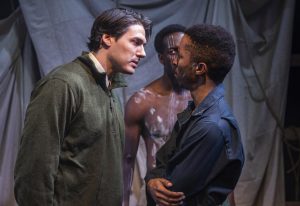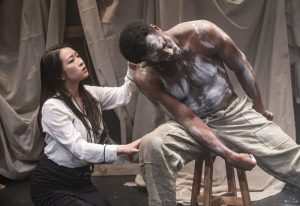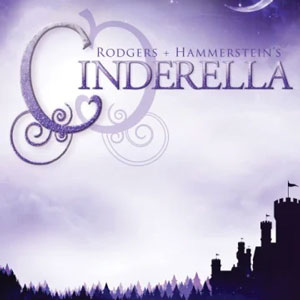
 Recommended *** Buoyed by phenomenal acting by David Goodloe and directed by Jerrell L. Henderson, “Mlima’s Tale” describes how animal poachers kill African elephants in violation of international law and work with smugglers and black marketeers to satisfy the demand for ivory, particularly in the Far East. The production is an amalgamation of Lynn Nottage’s highly cerebral script and the Griffin Theatre Company’s dramatics. A minimalist but appropriate set provides a splendid backdrop for a disturbing story that comes to life before us.
Recommended *** Buoyed by phenomenal acting by David Goodloe and directed by Jerrell L. Henderson, “Mlima’s Tale” describes how animal poachers kill African elephants in violation of international law and work with smugglers and black marketeers to satisfy the demand for ivory, particularly in the Far East. The production is an amalgamation of Lynn Nottage’s highly cerebral script and the Griffin Theatre Company’s dramatics. A minimalist but appropriate set provides a splendid backdrop for a disturbing story that comes to life before us.
Goodloe, who plays Mlima the elephant, is a formidable presence. What fantastic casting and acting! His mimicking of elephant behavior is a marvel to behold and makes the show memorable. We thoroughly enjoy listening to his translation of his elephant thoughts and vocalizations into clear and distinct English. As an animal from the wild, Mlima relates his memories and personal history as well as his pleasures, pains, and travails. Goodloe, with his ripped abs and gorgeous body—complete with effective body makeup—could not make for a more convincing pachyderm. He becomes Mlima via his body language: as a live elephant, as the spirit of a deceased one, and as the representation of the valued ivory tusks he once displayed. What a tribute to movement designer Jacinda Ratcliffe, who has choreographed all of this!
But who is Mlima? He is a living artifact, the pride of Kenya, and a national treasure. Yet his fame among gamekeepers and the general public has no bearing on those who stand to make a considerable profit from his death. With ivory as a symbol of purity, virtue, wealth, and splendor in many cultures, Mlima’s tusks are worth more than their weight in gold. Hence an African elephant today stands a better chance of being dead than remaining alive.
We follow Mlima’s deceased spirit from its home on the savannah through its wanderings in Kenya, Mogadishu, Malaysia, New Zealand, and points in between. As the provenance of the ivory becomes disputable, the prohibited cargo finally arrives in China, where a famed artist is hired to craft the prized tusks into unique carvings to satisfy the upscale Chinese market. From those who remove the ivory at night to those who mislabel the cargo and sneak it through customs in several countries to hide its origins and to those who ultimately sell it to the highest bidder, everybody in this chain of possession is complicit in the destruction of a threatened species. As dealers and middlemen involved in the trade provide some type of excuse or claim of ignorance or innocence, Goodloe (as Mlima’s spirit) paints ivory dust on them to signify their crimes against nature.
The Midwest premiere features a terrific cast, including Sarah Lo, Collin McShane, Christopher Thomas Pow, Ben Chaung, Michael Turrentine, and Lewon Johns. Johns doubles as the violence and intimacy designer and does an extraordinary job, especially in the way we see Mlima being tortured and killed. This brings up the most troublesome part of the performance: Mlima is slain much too close to the front the stage such that a good portion of the audience cannot see the exact way in which he dies.
Scenic design by Joy Ahn allows us to imagine the bush of Africa and as the cargo ships and clandestine containers they hold. Simple property design by Rachel Lambert works well in this regard. Costume designer Caitlin McLeod uses effective materials to create garments appropriate to each of the settings. Since many characters turn around and play other characters, often in the very next scene, it is essential for the audience to pay attention to the costumes that demarcate one scene from another.
The show is an important one, and this is an extremely confident performance. Nottage’s script is very straightforward and uncomplicated: Its purpose is to show us how conspicuous consumption drives the likely extinction of African elephants. We realize immediately that there can never be enough policing of this illegal trade. Despite laws against the importation and transport of ivory (which originally went into effect in 1990), the international black market has continued and, in recent years, has intensified. Since these laws have been largely subverted, senseless elephant deaths continue, and even the most treasured animals can no longer live out their lives fully without fear or threat of harm. If nothing is done about the status quo, our children and our children’s children will no longer be able to take pleasure in the magnificence of these huge and noble creatures. Perhaps if more people watch Nottage’s exposé, theatregoers can help raise consciousness among everybody—consumers, poachers, and the like—that animal preservation must trump aesthetics, especially in a world where there are so many functional equivalents to ivory as a medium for modern sculpture.
“Mlima’s Tale” takes place at the Raven Theatre’s Schwartz Stage, 6157 N. Clark Street, Chicago, and is playing through March 21, 2020.
Tickets are $38. Seniors, students, and veterans – $33.
Group discounts are available for groups of ten or more.
Thursdays, Fridays, and Saturdays – 7:30 p.m.
Sundays – 3:00 p.m.
Please note: There will be an added performance on Monday, March 16, at 7:30 p.m.
Tickets are available at www.griffintheatre.com or by calling 773-338-2177. There is free parking in the lot and along the streets at The Raven.
To see what others are saying, visit www.theatreinchicago.com, go to Review Round-Up and click at “Mlima’s Tale”







More Stories
“Pilot Island & Her Keepers” reviewed by Julia W. Rath
“Rodgers and Hammerstein’s Cinderella”
“Don’t Let The Pigeon Drive The Bus”